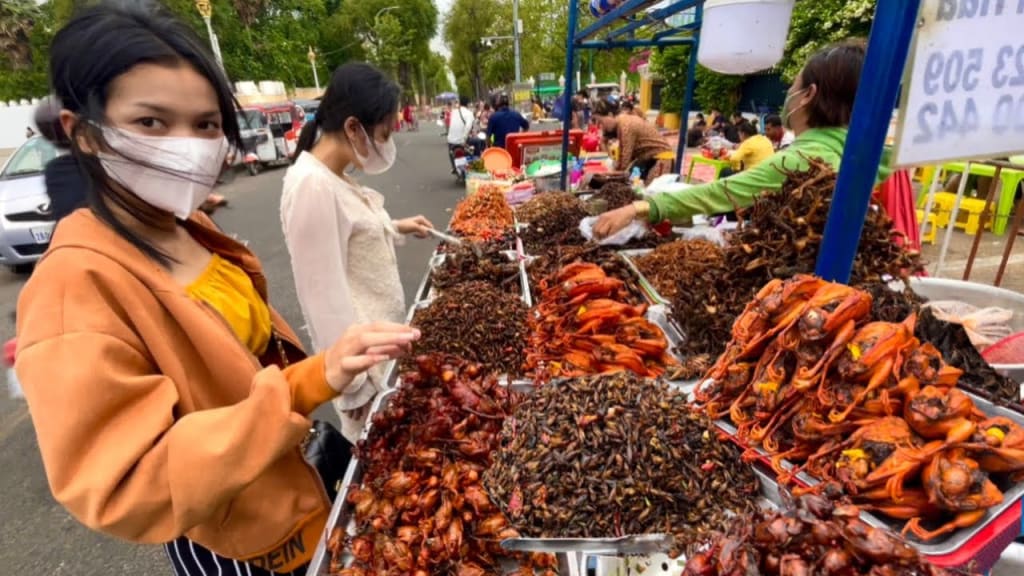Gourmet Delights:
"Unveiling China's Culinary Treasures for Adventurous Palates"

China is a country renowned for its rich history vast culture and delicious food. Factor in its stunning landscapes and diverse regions and it’s easy to see why millions of visitors flock to China every year. Foodies especially love the land of the Red Dragon thanks to its elaborate exotic dishes and unique snacks. As a tourist one of the best ways to experience a culture is through its cuisine.
Chinese cuisine is incredibly diverse with every region having its own unique style and flavor. From the steaming hot pots of Sichuan to the delicate dumplings of Shanghai the Chinese gastronomy is a must-have experience for all. If you plan to visit China and are a foodie it’s essential that you try some of the local snacks dishes and drinks during your trip.
The country has a wide range of regional specialties and incredibly exotic snacks that you won’t find anywhere else in the world.
In this article we will be highlighting the top 10 snacks drinks and dishes to try while visiting China. From Xiaolongbao to hot-pot these foods are delicious authentic and offer a true representation of Chinese culture. So pack your bags grab your chopsticks and join us as we take you on a culinary tour of China.
1. Snake Wine
The practice of drinking snake blood wine is popular in many Asian countries and is believed to have medicinal properties. It is thought to contain high levels of protein iron and other minerals that can boost the immune system and improve overall health. Additionally some people believe that consuming snake blood helps with sexual enhancement pain relief and energy-boosting.
Despite this belief the preparation and consumption of snake blood wine are controversial and some countries have banned the practice due to animal cruelty concerns. However in areas where it is legal snake blood wine is often served as a delicacy in traditional ceremonies or consumed as a form of entertainment.
The taste of this drink has been described as earthy and slightly bitter with a metallic aftertaste making it an acquired taste for many.
2. Bat Soup
This may sound unsettling to some but bat soup is considered a delicacy in some parts of the world. It is especially popular in countries like China Indonesia and Palau. The soup is believed to have medicinal properties including the ability to cure respiratory illnesses and boost the immune system.
However health experts warn against the consumption of bat soup due to the risk of transmission of diseases such as SARS and COVID-19 which are believed to have originated from bats. The consumption of bats is also a contributing factor to the decline in their population.
Despite this the practice of eating bat soup persists in some cultures as a tradition and a delicacy.
3. Drunken Shrimp
The delightful and captivating drunken shrimp dish boasts an exquisite culinary experience. Prepare to indulge in a lavish serving of succulent prawns, tantalizingly seasoned with an array of aromatic spices.
These prawns, once adorned with the carefully curated blend of flavors, find themselves immersed in a captivating elixir known as Baijiu. This potent liquor, renowned for its robust character, lends an intriguing depth to the dish.
Baijiu, traditionally crafted and cherished in China, typically possesses an alcohol content ranging between 40 and 60 percent by volume, making it a formidable libation. As its proof ranges between 80 and 100, this remarkable spirit carries a definitive presence that harmonizes with the prawns, further enhancing the overall gastronomic adventure.
Together, the interplay of the flavorful prawns and the intoxicating Baijiu creates an unforgettable symphony of taste and sensation.
4. Scorpion Lollipop
The Scorpion Lollipop is a unique and daring culinary creation that tantalizes the taste buds with its intriguing blend of flavors and textures. This extraordinary confectionery masterpiece features an actual scorpion encased in a sugary, transparent candy coating on a stick, resembling a lollipop.
The scorpion, carefully selected and prepared, adds a hint of exoticism and novelty to the treat. As one ventures to take a bite, they experience a captivating combination of sweet and savory flavors, as well as a subtle crunchiness from the scorpion’s exoskeleton.
The Scorpion Lollipop is not only a visually captivating delicacy but also a bold and adventurous gustatory experience that pushes the boundaries of culinary exploration.
5. Pig Brain
In the realms of Chongqing and Sichuan cuisine, the culinary landscape reaches new heights with the inclusion of brain as a delicacy. This prized ingredient finds itself artfully prepared and celebrated in a variety of ways, often gracing the barbecue or taking center stage in the fiery embrace of a spicy hot pot.
The exquisite texture and rich flavor of brain lend themselves remarkably well to these cooking methods, resulting in a gastronomic experience that is simultaneously bold and nuanced. Furthermore, in the southern reaches of China, pig brain takes on a unique role in the creation of tianma zhunao tang, a renowned dish that showcases the regional culinary finesse.
As diners partake in this exceptional delicacy, they are treated to a symphony of flavors, with the velvety brain infusing the tangy broth with its distinct essence, creating a captivating harmony of taste and texture.
6. Sheep Penis
Within the diverse culinary landscape of China, there exist dishes that may evoke strong reactions, with one such example being the consumption of sheep penis. While it may initially seem repulsive to some, it is important to understand the cultural context surrounding such dishes. In Chinese culture, there is a belief that consuming certain animal organs, including sheep penises and testicles, can potentially enhance desire and vitality.
It Is believed that the consumption of these unique delicacies provides natural boosts to libido, as an alternative to relying on pharmaceutical interventions. This cultural perspective is embraced by both men and women, who may opt for a platter of meticulously prepared sheep penises as a means to kindle their inner passions.
While it may challenge preconceived notions, it serves as a reminder of the rich diversity of culinary traditions and the intriguing beliefs that shape cultural practices.
7. Frog Legs
Frog legs are a delicacy in some parts of the world and are particularly popular in French and Chinese cuisine. In France frog legs are often served in garlic and butter sauce and in China they are deep-fried or stir-fried and served with a spicy sauce.
They are also commonly consumed in other countries such as Southeast Asia especially in Vietnam where they are often used in soups or fried dishes.
In the United States frog legs are also served in some restaurants particularly those that specialize in Cajun or Southern cuisine. However they are not as widely consumed in the US as they are In some other parts of the world.
8.Scorpions
Scorpions have been a part of traditional medicine in many cultures for centuries. They are believed to exhibit anti-inflammatory analgesic and anti-tumor properties. In Chinese medicine scorpion venom is used to treat arthritis and neuralgia.
Due to their high protein content scorpions are considered a good source of nutrition and can be consumed as a snack in some parts of the world. However it is important to be cautious when preparing scorpions for consumption.
They should be thoroughly cleaned and cooked to avoid any potential harm from their toxins. In conclusion while scorpions may not be a common or appealing food choice for many they do have potential health benefits when consumed appropriately.
9.Fried Seahorse
Seahorses have been used in traditional Chinese medicine for centuries believed to have healing properties that can treat a range of ailments from asthma to impotence. Their dried bodies are ground into powder and used to make medicines or as ingredients in health tonics.
Seahorse populations have been threatened due to overfishing for this purpose and some species are now considered endangered. In addition to medicinal use seahorses are also popular in the aquarium trade due to their unique appearance and interesting behavior.
However they require specialized care and their capture for the pet trade has also contributed to their decline in the wild. Conservation efforts are ongoing to protect seahorses and ensure their survival in the future.
10. Thousand Year Old Egg
Thousand-year-old eggs are a traditional Chinese delicacy that originated in Hunan China. While the preservation process may seem unappetizing to some it is actually a unique way of extending the shelf life of the eggs and improving their flavor.
The preserved duck eggs have a rich and creamy yolk with a distinct salty and umami flavor that pairs well with other strong flavors in Chinese cuisine. These eggs are often used in soup porridge or as a tasty snack on their own. Despite their name thousand-year-old eggs have a relatively short shelf life once they are removed from the preserving mixture so they should be consumed within a few weeks.
Today they can be found in specialty markets and restaurants all over the world giving people a chance to try this unusual gastronomic experience.






Comments
There are no comments for this story
Be the first to respond and start the conversation.